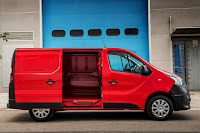Nissan launches the NV300 (at last)
Quite why Nissan has taken so long to introduce its NV300 is a mystery. After all, the virtually identical Vauxhall / Opel Vivaro was first revealed over two years ago and, since then, the virtually identical Renault Trafic and Fiat Talento have arrived.
Whatever the reasons, this Primastar replacement holds few surprises. The range comprises a panel van (available in H1 or H2 height configurations), a six-seat crew van and a nine-seat combi. All can be ordered in either L1 or L2 lengths.
Furthermore, there's also a floor cab version. Intended to accept bodywork from third-party suppliers, it's being offered in longer L2 guise only.
Power is provided by a Euro 6-compliant 1.6 litre turbocharged diesel engine, which uses an Adblue-based selective catalytic reduction system to cut down on NOx emissions.
Customers will be able to specify 94 bhp (70 kW / 95 PS), 118 bhp (88 kW / 120 PS), 123 bhp (92 kW / 125 PS) or 143 bhp (106 kW / 145 PS) outputs that are delivered via a six-speed manual transmission.
Economy is claimed to be better than the Primastar's. The 123 bhp panel van, for example, achieves 47.8 mpg (5.9 l/100km) and a CO2 figure of 155 g/km on the combined cycle.
That's not the only potential operating cost saving, though. Service intervals are two years / 40,000 kilometres (28,450 miles), while the factory warranty is a class-leading five years / 160,000 kilometres (99,420 miles).
NV300 production is going to take place at the same Sandouville plant in France that already builds the Renault Trafic. Sales are due to begin across Europe during November.
Related posts:
The NP300 Navara becomes Euro 6 compliant
Nissan e-NV200 SOFC prototype revealed
Whatever the reasons, this Primastar replacement holds few surprises. The range comprises a panel van (available in H1 or H2 height configurations), a six-seat crew van and a nine-seat combi. All can be ordered in either L1 or L2 lengths.
Furthermore, there's also a floor cab version. Intended to accept bodywork from third-party suppliers, it's being offered in longer L2 guise only.
Power is provided by a Euro 6-compliant 1.6 litre turbocharged diesel engine, which uses an Adblue-based selective catalytic reduction system to cut down on NOx emissions.
Customers will be able to specify 94 bhp (70 kW / 95 PS), 118 bhp (88 kW / 120 PS), 123 bhp (92 kW / 125 PS) or 143 bhp (106 kW / 145 PS) outputs that are delivered via a six-speed manual transmission.
Economy is claimed to be better than the Primastar's. The 123 bhp panel van, for example, achieves 47.8 mpg (5.9 l/100km) and a CO2 figure of 155 g/km on the combined cycle.
That's not the only potential operating cost saving, though. Service intervals are two years / 40,000 kilometres (28,450 miles), while the factory warranty is a class-leading five years / 160,000 kilometres (99,420 miles).
NV300 production is going to take place at the same Sandouville plant in France that already builds the Renault Trafic. Sales are due to begin across Europe during November.
Related posts:
The NP300 Navara becomes Euro 6 compliant
Nissan e-NV200 SOFC prototype revealed












%2BFront%2BSide.jpg)


Comments
Post a Comment